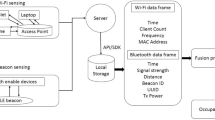Abstract
Knowing the presence or the actual number of occupants in a space at any given time is essential for the effective management of various building operation functions such as security and environmental control (e.g., lighting, HVAC). As occupants “interact” with the indoor environment, they will affect environmental conditions through the emission of CO2, heat and sound, and relatively little effort has been reported in the literature on utilizing this environmental sensing data for occupancy detection. This paper presents the findings of a study to address this question by exploring the most effective environmental features for occupancy level detection. A sensor network with robust, non-intrusive sensors such as CO2, temperature, relative humidity, and acoustics is deployed in an open-plan office space. Using information theory, the physical correlation between the number of occupants and various combination of features extracted from sensor data has been studied. The results show significant correlation between features extracted from humidity, acoustics, and CO2, while little correlation with temperature data. Using features from multiple sensors increases correlation further, and nearly 90% information gain is acquired when nine of the most informative features are combined.
Similar content being viewed by others
References
Anderson B, Moore A (1998). ADtrees for fast counting and for fast learning of association rules. In: Proceedings of the 4th International Conference on Knowledge Discovery and Data Mining (pp. 134–138), New York, USA.
Bauer P, Sichitiu M, Istepanian R, Premaratne K (2000). The mobile patient: Wireless distributed sensor networks for patient monitoring and care. In: Proceeding of the IEEE Conference on Information Technology Applications in Biomedicine (pp. 17–21), Arlington, USA.
Brona AD, A Damato (2007). Information entropy of a En: Bernoulli trial X. http://upload.wikimedia.org/wikipedia/commons/2/22/Binary_entropy_plot.svg. Accessed 30 Jan. 2012.
Burnham KP, Anderson DR (1998). Model Selection and Inference: A Practical Information Theoretic Approach. New York: Springer.
Cook DJ, Youngblood M, Heierman EO III, Gopalratnam K, Rao A, Litvin A, Khawaja F (2003). MavHome: An agent-based smart home. In: Proceedings of the IEEE International Conference on Pervasive Computing and Communications (pp. 521–524), Los Alamitos, USA.
Dodier RH, Henze GP, Tiller DK, Guo X (2006). Building occupancy detection through sensor belief networks. Energy and Buildings, 38: 1033–1043.
Federspiel CC (1997). Estimating the inputs of gas transport processes in buildings. IEEE Transactions on Control Systems Technology, 5: 480–489.
Harter A, Hopper A (1994). A distributed location system for the active office. IEEE Network, 8: 62–70.
Karp B, Kung HT (2000). Greedy perimeter stateless routing for wireless networks. In: Proceedings of the 6th Annual ACM/IEEE International Conference on Mobile Computing and Networking (pp. 243–254), Boston, MA.
Kumar S, Cengiz A, Deborah E (2000). Scalable object-tracking through unattended techniques (SCOUT). In: Proceedings of the 8th International Conference on Network Protocols (ICNP) (pp. 253–262), Osaka, Japan.
Laird CD, Biegler LT, van Bloemen Waanders BG (2007). Real-time, large scale optimization of water network systems using a subdomain approach. In: Biegler LT, Ghattas O, Heinkenschloss M, Keyes D, van Bloemen Waanders BG (eds), Real-Time PDE-Constrained Optimization (pp. 291–308), Philadelphia, USA: SIAM.
Lam KP, Höynck M, Zhang R, Andrews R, Chiou RS, Dong B (2009). Information-theoretic environmental features selection for occupancy detection in open offices. In: Proceedings of IBPSA Conference 2009 (pp. 1460–1467), Glasgow, UK.
Lesser V, Atighetchi M, Raja A, Regis B, Wagner T, Xuan P, Zhang SX (1999). The intelligent home testbed. In: Proceedings of the Autonomy Control Software Workshop (pp. 40–47), Seattle, USA.
Mitchell TM (1997). Machine Learning. New York: WCB/McGraw-Hill.
Moore A, Lee MS (1998). Cached sufficient statistics for efficient machine learning with large datasets. Journal of Artificial Intelligence Research, 8: 67–91.
Mozer M (1998). The neural network house: An environment that adapts to its inhabitants. In: Proceedings of AAAI Spring Symposium on Intelligent Environments (pp. 110–114), Stanford, USA.
Page J, Robinson D, Morel N, Scartezzini J-L (2008). A generalised stochastic model for the simulation of occupant presence. Energy and Buildings, 40: 83–98.
Shannon CE (1948). A mathematical theory of communication. Bell System Technical Journal, 27: 379–423.
Sohn MD, Reynolds P, Gadgil AJ, Sextro RG (2002). Rapidly locating sources and predicting contaminant dispersion in buildings. In: Proceedings of the 9th International Conference on Indoor Air Quality and Climate (pp. 17–21), Monterey, USA.
Torrance MC (1995). Advances in human-computer interaction: The intelligent room. In: Working Notes of the CHI 95 Research Symposium, Denver, USA.
Wang D, Federspiel CC, Rubinstein F (2005). Modeling occupancy in single person offices. Energy and Buildings, 37: 121–126.
Wang S, Burnett J, Chong H (1999). Experimental validation of CO2-based occupancy detection for demand-controlled ventilation. Indoor and Built Environment, 8: 377–391.
Author information
Authors and Affiliations
Corresponding author
Rights and permissions
About this article
Cite this article
Zhang, R., Lam, K.P., Chiou, YS. et al. Information-theoretic environment features selection for occupancy detection in open office spaces. Build. Simul. 5, 179–188 (2012). https://doi.org/10.1007/s12273-012-0075-6
Received:
Revised:
Accepted:
Published:
Issue Date:
DOI: https://doi.org/10.1007/s12273-012-0075-6




